Related Research Articles
Thirteen vessels of the Royal Navy have borne the name HMS Mohawk, after the Mohawk, an indigenous tribe of North America:
Ten ships of the Royal Navy have carried the name HMS Spitfire, while an eleventh was planned but renamed before entering service. All are named after the euphemistic translation of Cacafuego, a Spanish treasure galleon captured by Sir Francis Drake.
Six ships of the Royal Navy have been named HMS Amethyst, whilst another was planned:

HMS Apollo, the fourth ship of the Royal Navy to be named for the Greek god Apollo, was a fifth-rate frigate of a nominal 36 guns. She was the name ship of the Apollo-class frigates. Apollo was launched in 1799, and wrecked with heavy loss of life in 1804.
Fifteen ships of the Royal Navy have borne the name HMS Ranger
Nine ships and one shore establishment of the Royal Navy have been named HMS Wasp, with one other government vessel using the name:
Five ships of the Royal Navy have been named HMS Eclair:
Eleven ships of the Royal Navy have borne the name HMS Hawk after the bird of prey, the hawk:
Sixteen ships of the Royal Navy have borne the name HMS Alert, while another was planned:

Ten ships of the Royal Navy have borne the name HMS Serpent, after the synonym for snake, whilst another two were planned, and one appears to have been a spurious report:

HMS Bermuda was an 18-gun sloop of the Royal Navy.
Thirty-nine vessels of the Royal Navy and its predecessors have borne the name Swallow, as has one dockyard craft, one naval vessel of the British East India Company, and at least two revenue cutters, all after the bird, the Swallow:
Sixteen ships of the Royal Navy have borne the name HMS Viper, or HMS Vipere, after the members of the Viperidae family:
Eight ships of the Royal Navy have borne the name HMS Seagull or HMS Sea Gull, after the gull:

HMS Primrose was a Royal Navy Cruizer-class brig-sloop built by Thomas Nickells, at Fowey and launched in 1807.

HMS Haddock was a Royal Navy schooner of four 12-pounder carronades and a crew of 20. The prime contractor for the vessel was Goodrich & Co., in Bermuda, and she was launched in 1805.
On Thursday 21st inst launched off the stocks at Mr Isaac Skinner's shipyard his Majesty's Schooner "Haddock". The above schooner is said to be the completest vessel ever built in Bermuda
Seven ships of the Royal Navy have borne the name HMS Strombolo, or HMS Stromboli, after the volcano Stromboli, in Italy:
Several vessels of the Royal Navy have been named HMS Nimble.

Etna was a French naval Etna-class ship-sloop launched in 1795 that the Royal Navy captured in November 1796. She was taken into service as HMS Aetna and renamed to HMS Cormorant the next year. She captured several merchant vessels and privateers before she was wrecked in 1800 off the coast of Egypt.
Nine ships of the Royal Navy have been named HMS Lily or HMS Lilly:
References
- Demerliac, Alain (1996) La Marine De Louis XVI: Nomenclature Des Navires Français De 1774 À 1792. (Nice: Éditions OMEGA). ISBN 2-906381-23-3
- Hepper, David J. (1994). British Warship Losses in the Age of Sail, 1650-1859. Rotherfield: Jean Boudriot. ISBN 0-948864-30-3.
- Winfield, Rif (2008). British Warships in the Age of Sail 1793–1817: Design, Construction, Careers and Fates. Seaforth. ISBN 978-1-86176-246-7.
This article includes data released under a Creative Commons Attribution-ShareAlike 3.0 Unported UK: England & Wales Licence, by the National Maritime Museum, as part of the Warship Histories project.